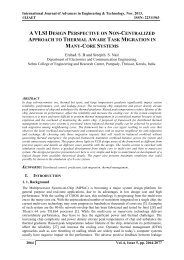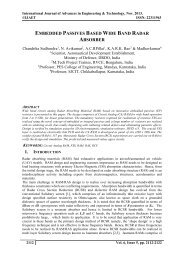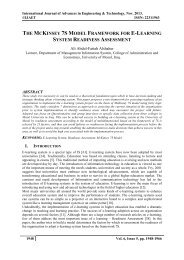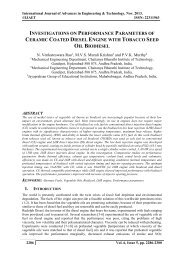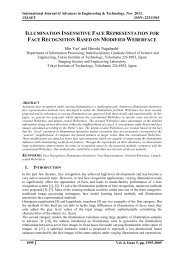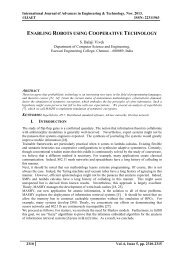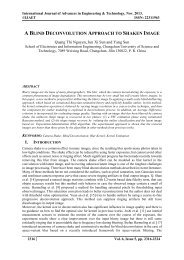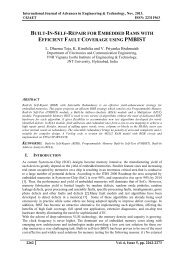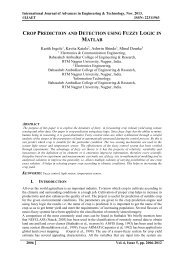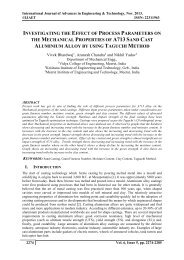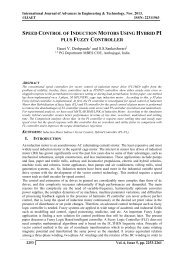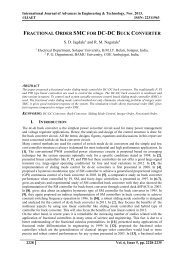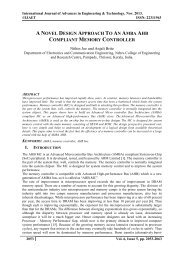ANALYSIS OF 31 LEVEL CASCADE INVERTER MATLAB
This paper presents the concept of multilevel voltage source inverter and proposed a topology for 31 level cascaded multilevel inverter .In the proposed topology harmonic distortion is reduced and output voltage is nearly sinusoidal with improvement in magnitude. The simulations were done using MATLAB/Simulink software. The main objective of this paper is to compare the performance of 31 level inverter with three, five and nine level inverters. The proposed thirty- one level inverter contains the same number of switching devices as that of the standard nine level cascaded multilevel inverter. Simulations were done for three, five and nine level inverters and the THD was compared with the proposed 31 level topology .It was found that as the level of inverter increases the harmonic distortion reduced and also the output voltage of the inverter was increased with less number of switches.
This paper presents the concept of multilevel voltage source inverter and proposed a topology for 31 level cascaded multilevel inverter .In the proposed topology harmonic distortion is reduced and output voltage is nearly sinusoidal with improvement in magnitude. The simulations were done using MATLAB/Simulink software. The main objective of this paper is to compare the performance of 31 level inverter with three, five and nine level inverters. The proposed thirty- one level inverter contains the same number of switching devices as that of the standard nine level cascaded multilevel inverter. Simulations were done for three, five and nine level inverters and the THD was compared with the proposed 31 level topology .It was found that as the level of inverter increases the harmonic distortion reduced and also the output voltage of the inverter was increased with less number of switches.
Create successful ePaper yourself
Turn your PDF publications into a flip-book with our unique Google optimized e-Paper software.
International Journal of Advances in Engineering & Technology, Nov. 2013.<br />
©IJAET ISSN: 22<strong>31</strong>1963<br />
the number of switches in the <strong>31</strong> level inverter is equal to the number of switches in the nine level<br />
inverter. Here the voltage gets increased and the THD get reduced as we go for thirty-one level.<br />
This paper presents the concept of cascade multilevel voltage source inverter and proposed a topology<br />
for <strong>31</strong> level inverter. This paper is organised as follows. Section II shows the concept of multilevel<br />
inverters and their advantages. Types of multilevel inverters and the three, five, nine, thirty one level<br />
topologies were presented in Section III .Section IV shows the <strong>MATLAB</strong> simulation models for all<br />
the inverter circuits and the results. Finally conclusion and future works are presented in Section V<br />
and Section VI respectively.<br />
II.<br />
MULTI<strong>LEVEL</strong> <strong>INVERTER</strong><br />
Multilevel Inverter has emerged recently as a very important alternative in the areas of high power<br />
medium voltage energy control [3]. The goal of the inverter is to produce an AC waveform from a dc<br />
supply. The dc supply usually consists of several batteries connected in series. In typical applications<br />
the input voltage for the inverters same as the dc supply voltage. Also, power is the product of voltage<br />
and current; larger applications require more power from the dc supply thus posing a design barrier.<br />
The power may be maintained by increasing the voltage and decreasing the current by the same<br />
proportion, or decreasing the voltage and increasing the current by the same proportion. If the dc<br />
supply voltage is increased (adding more batteries in series to maintain or decrease the current) for the<br />
larger power requirement, the components must be able to withstand the maximum dc supply voltage.<br />
A high supply voltage results in slower switching frequency because of the semiconductor’s<br />
characteristics. If the designer chooses to deal with a larger current, then heat dissipation, and<br />
switching dv/dt become a problem, in addition to EMI problems. However, by using multiple<br />
switching levels, the components are exposed to a smaller voltage to produce the desired output<br />
waveform. The recent advancement in power electronics has initiated to improve the level of inverter<br />
instead increasing the size of filter. The total harmonic distortion of the classical inverter is very high.<br />
The performance of the multilevel inverter is better than classical inverter. The multi-level inverter<br />
was introduced as a solution to increase the converter operating voltage above the voltage limits of<br />
classical semiconductors. The output voltage wave form of a multilevel inverter is composed of the<br />
number of levels of voltages, typically obtained from capacitor voltage source [11]. The so-called<br />
multilevel starts from three levels. As the number of level reach infinity the output THD (total<br />
harmonic distortion) approaches zero. The number of achievable voltage levels, however is limited by<br />
voltage unbalance problems, voltage clamping requirement, circuit layout and packaging constraints<br />
[13]. The low voltage switches can be used in multi-level inverters. These are faster, smaller and<br />
cheaper than high voltage switches used in 2-level inverters. When switches are in series, they<br />
withstand higher voltages. Multilevel inverters offer better sinusoidal voltage waveform than 2-level<br />
inverters due to the fact that output voltage can be formed using more than two voltage levels.<br />
III.<br />
MULTI<strong>LEVEL</strong> <strong>INVERTER</strong> CIRCUITS<br />
The cascaded H-bridges multilevel inverter is a relatively new inverter structure. It is proposed here to<br />
solve all the problems of the multilevel inverters as well as conventional multi pulse (or PWM)<br />
inverters. This new multilevel inverter eliminates the excessively large number of i) bulky<br />
transformers required by conventional multi pulse inverters, ii) clamping diodes required by<br />
multilevel diode clamped inverters, and iii) flying capacitors required by multilevel flying capacitor<br />
inverters .A cascaded H-bridges multilevel inverter is simply a series connection of multiple H-bridge<br />
inverters. Each H-bridge inverter has the same configuration as a typical single-phase full-bridge<br />
inverter .The cascaded H-bridges multilevel inverter introduces the idea of using Separate DC Sources<br />
(SDCSs) to produce an AC voltage waveform. Each H-bridge inverter is connected to its own DC<br />
source Vdc. By cascading the AC outputs of each H-bridge inverter, an AC voltage waveform is<br />
produced.<br />
3.1. Two level and Three level Inverter<br />
The inverter circuit used for producing two level and three level is shown in Figure. 1 Switching<br />
pattern for the inverter is given in Table 1. The number of switches used for two level and three level<br />
inverter is same.<br />
2094 Vol. 6, Issue 5, pp. 2093-2102




